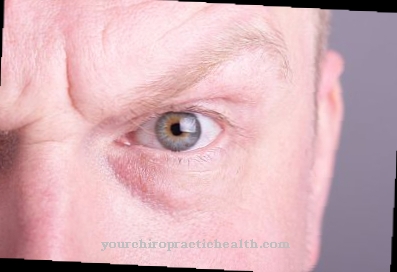Seborrhea, also as seborrheic eczema or seborrheic dermatitis is a skin inflammation. The greasy, scaly inflammation occurs on the hairy head, trunk and face. Those areas of the skin that are affected by seborrhea are reddened, with oily, yellowish scales also developing. In a few cases, patients complain of severe itching.
What is seborrhea?

The doctor uses the term seborrhea (or seborrheic dermatitis or seborrheic eczema) to refer to skin inflammation. In particular, such inflammations develop on areas of the skin that have a large number of sebum glands. Excessive secretions from the sebum glands are characteristic, so that a very thick film of fat develops on the skin.
causes
There are many reasons and causes of seborrhea. The skin has several layers of cells that - in healthy people - are subject to a permanent renewal process. Skin cells form inside the skin, which displace the old outside of the skin. The old skin cells die off so that new cells can form. The flakes of skin that fall off as part of that renewal cannot be seen. However, if seborrhea is present, the flakes of skin are shed in large, very greasy flakes. There is a disorder of skin renewal.
What the exact causes of seborrhea are is not yet fully known. However, doctors assume that it is an inflammation of the hair follicles. The causes are possible infections with yeasts (such as Pytriosporum orbiculare, Pytriosporum ovale or Malassetia furfur). Those harmless "residents" can multiply in such a way that seborrhea can be triggered.
Favorable factors are hormonal factors (e.g. testosterone) or climatic influences (moisture and heat). Sometimes physical and psychological stress can also play a role. Especially when the patient repeatedly complains about "relapses" that are possible with a chronic course of the disease. In the actual sense of the word, seborrhea is not an independent disease, but a symptom that, in turn, says little about the causal disease.
Diseases with this symptom
- Pityriasis versicolor
- Seborrheic eczema
- Blepharitis
Diagnosis & course
The doctor already makes the diagnosis of seborrhea - only on the basis of the skin examination. Here one speaks of the so-called "eye diagnosis". However, there are also cases in which it cannot be clearly established whether seborrhea is present. Sometimes other forms of skin diseases (such as atopic or allergic eczema) can trigger symptoms similar to those of seborrhea.
Psoriasis - psoriasis - can also show a similar complexion. It is important that the doctor rule out other diseases before diagnosing seborrhea. Sometimes allergy tests can provide information about whether seborrhea is actually present. There is also an option for the flakes of skin to be examined microscopically so that the doctor can confirm that seborrhea is indeed present.
The problem with the disease is that seborrhea can take a chronic course. Especially if the seborrhea occurs in infancy, there is a risk of other infections, so that the already affected skin areas can be attacked by other fungi or bacteria. Even in adulthood, it is possible for bacteria to infect other skin areas or to settle in areas that have already been attacked; here the doctor speaks of a superinfection.
Furthermore, seborrhea - especially in babies - can be so severe that so-called Erythrodermia desquamativa Leiner occurs. This stage is mainly observed in the child's second month of life. The entire skin is affected, with the infant vomiting, having a high fever and suffering from diarrhea.
The prognosis is good, especially in infancy. Seborrhea usually heals by itself - after several weeks. However, adults suffer from a chronic course that recurs in attacks. The clinical picture is similar to psoriasis or neurodermatitis. The likelihood that seborrhea will completely heal is extremely small. Only if careful care measures are taken can sufferers control the symptoms so well that relapses of the disease can sometimes be avoided.
Complications
Seborrheic eczema or seborrheic dermatitis mainly affects the face, scalp and both sides of the upper body. In newborns, the symptom is known as gneiss, grind, or cradle cap. This symptom usually heals on its own by the age of nine months. Seborrhea occurs as a dermatitis variant in the adolescence phase and between the ages of 40 and 50 years. Stress and medication encourage an outbreak.
Immunodeficient people, patients with Parkinson's disease and Down syndrome are more affected by the symptom. The resulting complications can, depending on the severity of the course, reduce the patient's zest for life. These include crust formation, bacterial infections from constant scratching, bleeding, scarring and hair loss. As the disease progresses, those affected often find themselves in a depressed state.
Adults who suffer from seborrhea are considered chronically ill and can expect a new outbreak at any time. Another complication of eczema can be sebum hyperplasia and rhinophyma. With the latter diagnosis, the sebum enlargement changes the nose, especially in older men, like a bulb. In extreme cases, the sebum glands have to be surgically cut out.
Seborrhea should be treated immediately and treated under dermatological supervision. This saves many of those affected an almost unbearable ordeal. In addition, permanent cosmetic impairments and other problems are excluded.
When should you go to the doctor?
Seborrhea is relatively harmless to health and usually resolves on its own. However, if the psoriasis is unusually large or if accompanying symptoms develop such as itching and redness, this should be discussed with your family doctor or pediatrician. In the case of weeping or bleeding areas as well as inflammation, a visit to the dermatologist is recommended.
Seborrheic eczema on the face, neck or hands and feet should be clarified if they cause symptoms or have a negative effect on the general well-being. If left untreated, the cosmetic blemish can develop into emotional stress, which can sometimes lead to severe psychological problems. Physical symptoms can also develop from untreated seborrhea.
It is therefore advisable to clarify seborrhea as early as possible and, if necessary, treat it. Otherwise the skin disease can take a chronic course and promote bacterial or fungal infections. Seborrhea in children and adolescents must always be medically clarified. If psoriasis is detected and treated early, a severe course can usually be avoided.
Doctors & therapists in your area
Treatment & Therapy
Seborrhea usually requires therapy that has two parts. On the one hand, the treatment is based on the acute stage; on the other hand, maintenance therapy is prescribed, which must be applied “between the attacks”.
In the context of the acute stage, it is important that the person concerned receives medication which subsequently has a fungicidal effect (so-called antimycotics). These agents can be applied directly - in the form of an ointment - to the affected areas. There are also shampoos and lotions that contain the same active ingredient. If the symptoms are persistent and pronounced, antifungal drugs can also be given in tablet form.
If there are additional infections - i.e. a superinfection - the patient must take antibiotics. For extremely inflamed forms, the doctor will also prescribe glucocorticoids (as an ointment). The glucocorticoids should contain the inflammatory response. However, glucocorticoids are not administered as part of long-term therapy.
Keratolytics must be used if there is extremely pronounced dandruff. These sometimes include urea and salicylic acid; those substances soften the skin flakes. As a result, the flakes of skin peel off, so that an improvement in the clinical picture occurs.
Outlook & forecast
A doctor does not always have to be consulted with seborrhea, and complications do not necessarily arise. If the disease is not treated, the course of the disease will depend on the patient's hygiene. If this is inadequate, the skin usually remains oily and further complications arise. In the case of seborrhea, for example, inflammation and wounds on the skin can occur, which in extreme cases leave scars or lead to a serious infection.
If the seborrhea is mild, the prognosis is rather positive. Ordinary shower gels and soaps are usually sufficient to reduce oily skin and alleviate any accompanying symptoms such as itching or odor development. Seborrhea as a result of frequent showering can be alleviated with special, gentle care products for sensitive skin.
A doctor's visit is recommended if the skin has suddenly become oily and the symptoms cannot be relieved by washing. If the seborrhea is treated quickly and specifically, the symptom can be eliminated quickly and reliably. In order to avoid oily skin after successful therapy, the causes must also be treated.
prevention
General prevention is not possible. However, those who tend to have oily skin or who sweat a lot must ensure that they clean and care for their skin regularly. It is important that skin-neutral substances are used. In many cases, maintenance with clear water is sufficient.
You can do that yourself
Seborrhea, i.e. the overproduction of skin fats by the sebum glands, is often only viewed as a cosmetic problem, particularly in the form of seborrhoea oleosa, which is associated with oily skin and oily hair. The possibilities for therapeutic influence on the mostly particularly badly affected areas on the forehead, nose and chin are considered to be limited.
A number of medicinal and cosmetic creams and ointments are offered in pharmacies that have an astringent effect and are intended to reduce the gloss of the skin. The use of mattifying facial toner or matting powder is also helpful. Special products are available in pharmacies and drugstores that reduce the shine of the skin for hours.
In natural medicine, attempts are made to treat the cause of the problem. A “blood cleansing” with nettle tea or an intestinal cleansing and a subsequent therapeutic fasting for several weeks is recommended here. A number of medicinal herbs are also used, in particular field horsetail, dock, birch, blackberry, watercress, wild garlic, buttercup, grouse, chamomile, burdock, mint, blackthorn, waterweed, chicory and wormwood. The herbs are used differently. Some herbalists recommend making a brew or making alcoholic tinctures to apply to the skin. Steam baths should also be effective, with salt water or chamomile tea being used in particular.
Treatment with apple cider vinegar is particularly effective. For this purpose, organic apple cider vinegar is mixed with water in a ratio of 1: 1 and then the affected areas of the skin are rubbed with it.

.jpg)






















.jpg)



